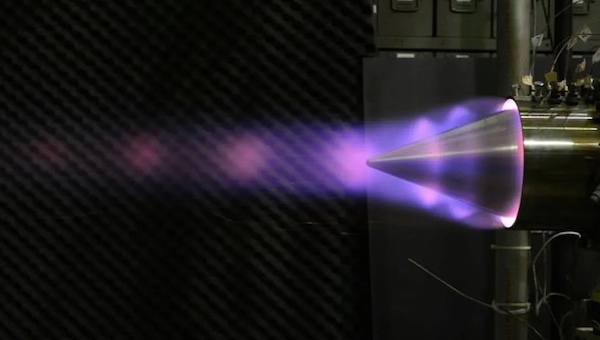
IMAGE OF AN AFRL ROTATING DETONATION ENGINE RIG TEST.
AFRL
CHINA DEVELOPS 'WORLD'S MOST POWERFUL' HYPERSONIC ENGINE THAT COULD REACH MACH 16
BY: CHRISTOPHER MCFADDENORIGINAL SITE: INTERESTING ENGINEERING
Chinese engineers claimed to have created a "revolutionary" dual-mode rotating detonating and straight-line oblique detonation engine setup.
Chinese hypersonic weapons researchers have allegedly developed the "world's most powerful rotating detonation engine," the South China Morning Post (SCMP) reported on Wednesday.
Referred to as "revolutionary," the new air-breathing engine should carry an aircraft to 18.6-mile (30 km) altitudes and travel around Mach 16. If true, at this velocity, intercontinental flights should take only hours and consume far less fuel when compared to conventional jet engines.
"Revolutionary" new engine
Designed by Zhang Yining and his team at the Beijing Power Machinery Institute (in conjunction with the People's Liberation Army's 93160 Unit), little is known about the engine beyond a blueprint published in the peer-reviewed journal Chinese Journal of Propulsion Technology in December SCMP reports. The engine operates in two modes, with the first being a sub-Mach 7 mode, which works as a continuous rotating detonation engine (RDE). Air from outside mixes with fuel and gets ignited, which leads to the creation of a shock wave.
See Also
Related
This shock wave propagates in an annular chamber. During rotation, the shock wave ignites more fuel, resulting in a powerful and continuous thrust for the aircraft. China, the United States, and other nations like Japan are currently working on their own RDE concepts with NASA, and contractors like GE recently tested prototype engines on the ground. China has also reported breakthroughs in RDE technology recently with its own ground tests and even a drone variant.
In the second mode, when the aircraft travels above Mach 7, the shock wave stops rotating and focuses on a circular platform at the engine's rear. This helps maintain the thrust through a nearly straight-line oblique detonation format. As the researchers describe in the paper, fuel auto-detonates as it reaches the rear platform due to the high speed of incoming air. The engine relies on detonation as its primary driving force throughout its operation.
Zhang and his colleagues did not disclose the efficiency of their engine in their research paper. However, based on previous scientific estimates, the explosion of combustible gases can convert nearly 80% of chemical energy into kinetic energy. This is a significant improvement compared to conventional turbofan engines, which typically achieve 20-30% efficiencies and rely on slow and gentle combustion.
Zhang's team claims that their design, which integrates rotational and straight-line detonation across a wide speed range, is a "world first" testament to Chinese ingenuity. “This solution has obvious advantages and is expected to improve the optimal thermodynamic cycle efficiency in nearly all speed ranges, bringing a revolutionary change in aerospace propulsion,” the researchers said.
According to Zhang's team, the transition to the new detonation engine was challenging due to the two operating modes. As the speed approached Mach 7, the rotating detonation mode became unsustainable. Therefore, the oblique detonation mode had to be ignited quickly. According to the authors, there are some potential solutions to the problem.
One is to decrease the incoming air speed from Mach 7 to Mach 4 or even lower. This will allow the fuel to heat up adequately for auto-ignition. Another solution is to make slight adjustments to the engine's internal structure, such as modifying the diameter of the circular platform and the angle of the shock wave tilt. These modifications could have an impact on the engine's overall performance.
More work need to be done
According to the researchers, the engine was relatively undemanding in operating conditions and could operate efficiently in most common scenarios, noted the SCMP report .
However, they also noted that relying solely on the information presented in the paper would not be enough to create a practical, usable product. This is because certain crucial engineering parameters, such as the limited space available for the airflow path, were not included in the paper.
AWFSM CATEGORIES
Activism | AI | Belief | Big Pharma | Conspiracy | Cult | Culture | Deep State | Economy | Education | Entertainment | Environment | Faith | Global | Government | Health | Hi Tech | Leadership | Politics | Prophecy | Science | Security | Social Climate | Universe | War
